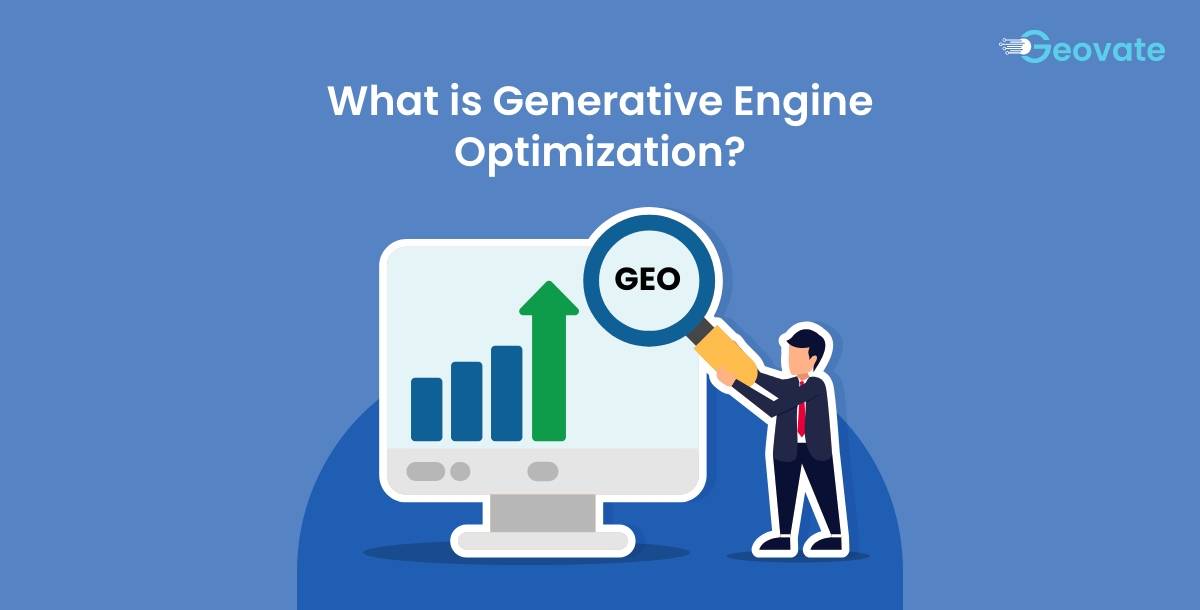What is Generative Engine Optimization (GEO)?
Tue,05 Aug 2025 15:39:00- Font Size
- Share Content

As the digital landscape evolves, a new frontier emerges at the intersection of search and artificial intelligence: Generative Engine Optimization. Gone are the days when traditional search engine algorithms alone dictated online visibility. Today’s users increasingly rely on AI-powered answer interfaces—often referred to as answer engines—that generate concise, relevant responses to their queries. For businesses seeking to capture this burgeoning traffic stream, investing in GEO Services and Answer Engine Optimization Services is no longer optional—it’s essential. In this comprehensive guide, we’ll explore the concept of generative engine optimization, the suite of AEO Services and GEO Services that Geovate offers, and actionable strategies to ensure your content excels in the era of AI-driven information retrieval.
What Is GEO?
Generative Engine Optimization (GEO) refers to the systematic practice of tailoring digital content so that AI-driven answer engines—such as ChatGPT, Google’s AI summaries, or any custom knowledge assistants—can digest, interpret, and present it as high-quality responses to user queries. Unlike traditional SEO, which focuses on ranking web pages in search engine results pages (SERPs), GEO zeroes in on being the very content that AI models surface when they “answer” a user’s question.
Key characteristics of generative engine optimization include:
- Semantic Structuring: Organizing content into clear, self-contained chunks—often using headings, bullet points, and FAQ-style Q&A—to align with AI extraction patterns.
- Data-Centric Enrichment: Incorporating structured data (schemas, JSON-LD) that AI agents can parse to extract precise facts.
- Prompt Alignment: Crafting headings and opening sentences that mirror common user prompts, so the AI “knows” this section directly addresses a likely question.
- Authority Signals: Embedding authoritative insights—case studies, statistics, unique analyses—that AI models recognize as credible and thus favor when constructing answers.
By optimizing content through these lenses, brands enhance their likelihood of being directly quoted by AI assistants, leading to increased brand visibility and traffic from AI-driven interfaces.
Why GEO Matters for Modern Marketers
The rise of conversational AI and large language models has fundamentally altered how users seek information:
1. Shift to Zero-Click Environments
Studies show a growing percentage of queries are resolved without clicks to an external site. Instead, AI agents synthesize knowledge from across the web—presenting it directly within the chat. Without a robust GEO Services strategy, your brand risks invisibility in these zero-click contexts.
2. Voice and Conversational Interfaces
Voice assistants (e.g., Siri, Alexa) increasingly lean on generative models to answer complex questions. Implementing Answer Engine Optimization Services ensures your content is structured to be picked up by these voice-driven experiences.
3. Enhanced User Expectations
Users now expect instant, accurate answers. If your content isn’t optimized for direct extraction and summarization, AI engines may default to competing sources—even if your page ranks highly in traditional SERPs.
4. Early-Mover Advantage
As GEO remains an emerging discipline, brands that invest in generative engine optimization today can establish leadership and secure AI-driven traffic before the market becomes saturated.
Traditional SEO vs. Generative Engine Optimization
Aspect Traditional SEO Generative Engine Optimization
Primary Goal Rank web pages on SERPs Become the source content AI models surface
Key Signals Backlinks, keyword density, page load speed Semantic clarity, structured data, prompt matching
Content Structure Paragraph-centric, long-form articles Modular, Q&A blocks, schemas, summaries
Performance Metric Organic search rankings, click-through rate (CTR) AI answer inclusion rate, conversational reach
Optimization Focus HTML meta tags, title tags, image alt attributes Schema markup, FAQ schema, targeted prompt framing
Understanding these differences helps marketers reallocate efforts: while standard SEO remains important, an integrated strategy that includes AEO Services ensures holistic visibility across both traditional and AI-driven search landscapes.
Core Components of Effective GEO Services
When engaging with a GEO Services provider like Geovate, you can expect a multi-faceted approach that encompasses:
1. Content Audit & Gap Analysis
- Assess existing content for AI-readiness: Are headings clear prompts? Are facts easily extractable?
- Identify high-value topics lacking structured data or semantic clarity.
2. Schema & Structured Data Implementation
- Deploy relevant schema types (FAQPage, HowTo, Organization) to flag critical information for AI parsers.
- Leverage JSON-LD snippets to encapsulate definitions, steps, or data points.
3. Prompt-Based Content Design
- Craft headings and subheadings as direct questions (e.g., “What Is Generative Engine Optimization?”).
- Provide succinct, standalone answers immediately beneath each question to facilitate AI extraction.
4. Answer Snippet Optimization
- Optimize key 40–60 word summaries for likely snippet inclusion.
- Use numbered or bulleted lists where appropriate to align with common answer formats.
5. Internal Linking & Knowledge Graph Signals
- Reinforce content clusters by interlinking related topics with semantically relevant anchor text.
- Signal content hubs that represent authoritative knowledge domains.
6. Training Data Collaboration
- For proprietary AI engines, supply clean datasets and feedback loops to refine model outputs.
- Work with AI teams to annotate content sets for fine-tuning.
7. Performance Tracking & Reporting
- Monitor AI-driven traffic sources, answer hit rates, and user engagement on extracted snippets.
- Iterate on content based on AI performance metrics.
Unlocking Growth with Answer Engine Optimization Services
Alongside generative engine optimization, Answer Engine Optimization Services (AEO Services) focus specifically on ensuring that AI assistants deliver your content as concise, accurate answers. These specialized services include:
- Query Intent Modeling: Analyzing user queries to predict the most probable phrasing and informational needs that AI will encounter.
- Answer Formatting: Structuring responses to conform with known answer templates (definition boxes, quick facts, step guides).
- Multimodal Asset Alignment: Preparing text, images, and infographics so AI agents can blend modalities when generating answers.
- Voice-First Optimization: Adjusting phrasing and sentence length for optimal comprehension in auditory interfaces.
- Continuous Tuning: Regularly updating content snippets to reflect algorithm changes in leading generative models.
By integrating AEO Services into your digital strategy, you ensure that whether a user asks a typed question, speaks into a voice assistant, or interacts with a chat interface, your brand’s content stands out as the definitive answer.
Geovate’s Suite of GEO & AEO Services
At Geovate, our mission is to empower businesses to thrive in the AI-driven information era. Here’s an overview of our comprehensive service offerings:
Service Category Description
GEO Strategy & Consulting Hands-on workshops and strategic roadmaps tailored to your industry, ensuring seamless integration of generative engine optimization practices.
Content Engineering Production of AI-ready content assets, from FAQ modules to schema-embedded articles, optimized for direct extraction by answer engines.
Technical SEO & Schema Markup Advanced implementation of structured data, from basic entity markup to complex knowledge graphs, boosting AI parseability.
AEO Implementation Dedicated workflows for answer snippet crafting, conversational prompt alignment, and voice-interface readiness.
Model Fine-Tuning Support Collaboration with in-house AI teams or external vendors to provide curated datasets and annotations for proprietary answer engines.
Analytics & Reporting Dashboards tracking AI answer placements, conversational completion rates, and downstream click-throughs to your site or app.
Best Practices for Generative Engine Optimization
While partnering with expert GEO Services can accelerate your progress, implementing these best practices in-house will set you up for success:
1. Adopt a Question-First Mindset
Frame each key topic around a specific user question. For instance, instead of writing “Our Digital Marketing Solutions,” title the section “What Digital Marketing Solutions Does Geovate Offer?”
2. Write Clear, Concise Answers
AI models favor brevity. Aim for 40–80 words per answer block, using simple, direct sentences and active voice.
3.Use Schema Liberally—but Wisely
Implement both general (Organization, WebPage) and specific (FAQPage, HowTo) schemas. Validate markup with tools like Google’s Rich Results Test to ensure proper structure.
4.Leverage Data and Statistics
Incorporate concrete figures—percentages, timeframes, benchmarks—that AI can surface as quick facts, enhancing the perceived authority of your content.
5.Optimize for Voice and Conversational Tone
Read your answers aloud. If sentences feel stilted, revise for a more natural conversational flow to aid comprehension in voice-first contexts.
6.Maintain Content Freshness
AI engines often prioritize recent information. Regularly update statistics, case studies, and legal or regulatory sections to stay relevant.
7.Monitor AI Answer Performance
Use analytics platforms that track where and how often your content is used by AI services. Analyze drop-off points in conversational flows to optimize follow-up content.
Case Study: From Invisible to Indispensable
Client: A leading B2B software provider
Challenge: Despite ranking on page one of Google for key terms, the client saw minimal traffic from voice assistants and generative AI chats.
Solution:
1. GEO Audit & Prompt Alignment
Reframed 120 existing articles into question-and-answer modules, embedding FAQPage schema.
2. AEO Snippet Design
Crafted 80 concise answer snippets tailored for top-priority user intents and tested them against multiple AI platforms.
3. Structured Data Overhaul
Expanded schema implementation to include Product, Service, and Article markup, enhancing AI parsing capacity.
Results:
- 250% increase in AI-driven traffic within three months.
- 60% uplift in voice assistant referrals.
- 35% reduction in bounce rate on AI-extracted landing pages.
This success underscores how targeted generative engine optimization and answer engine optimization services can transform hidden content into high-impact assets.
Integrating GEO and AEO into Your Workflow
To build a sustainable, scalable approach for Generative Engine Optimization and Answer Engine Optimization Services, consider the following integration points:
1.Editorial Calendar Alignment
Flag high-priority content for GEO/AEO optimization during the planning phase.
2.Cross-Functional Collaboration
Involve SEO specialists, content strategists, and AI engineers in joint workshops to harmonize technical and editorial goals.
3.Template-Driven Content Creation
Develop reusable templates for FAQ sections, How-To guides, and quick facts, ensuring consistency across the site.
4.Automated Schema Deployment
Use CMS plugins or custom scripts to auto-generate JSON-LD based on structured fields, reducing manual markup errors.
5.Continuous Learning Loops
Establish feedback channels where AI performance data (e.g., answer hit rates) informs subsequent content updates and new topic selection.
Future Trends in Generative Engine Optimization
As AI technologies continue to advance, several emerging trends will shape the next frontier of GEO and AEO Services:
- Multimodal Answer Synthesis
AI models will increasingly blend text, images, and video clips into unified answers. Brands must optimize all asset types for direct AI consumption.
- Personalized Answer Engines
Answers tailored to user profiles, location, and past interactions will dominate. Dynamic content modules that adapt in real-time will become key differentiators.
- Conversational Agent Marketplaces
Third-party answer engine platforms will allow brands to publish custom “skills” or “actions.” GEO strategies will expand to these ecosystems.
- AI Transparency Requirements
Regulatory scrutiny may mandate that AI assistants disclose information sources. Well-structured content with clear attributions could gain preference.
- Hybrid Human-AI Content Workflows
The line between AI-generated drafts and human-edited final content will blur. Effective GEO teams will leverage AI for initial drafts, then refine for brand voice and accuracy.
Conclusion
In an era where AI-driven answer engines are redefining how users consume information, Generative Engine Optimization and Answer Engine Optimization Services represent the critical next step for forward-thinking businesses. By embracing GEO Services, organizations can ensure their content isn’t just discoverable—but also directly extractable and authoritative within AI interfaces. Coupled with targeted AEO Services, brands can secure top placement in voice assistants, chatbots, and other generative platforms, capturing a new wave of zero-click, zero-scroll engagements.
At Geovate, we specialize in delivering end-to-end GEO and AEO solutions that align with your unique goals—whether you’re a B2B SaaS provider, an e-commerce leader, or an enterprise seeking to innovate your knowledge delivery. Reach out today to explore how our GEO Services and AEO Services can propel your content strategy into the future of AI-driven discovery.
